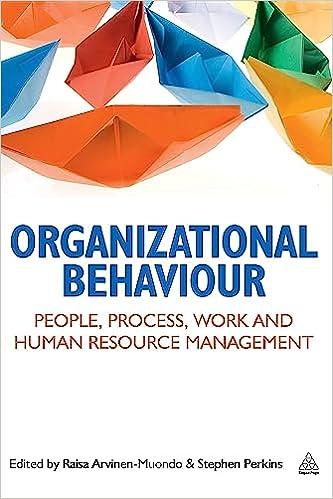CoCre8 is a provider of business improvement and innovative services and solutions including communication and motivation, performance,
Question:
CoCre8 is a provider of business improvement and innovative services and solutions including communication and motivation, performance, incentive programmes and events management. Previously an independent small business, the company was acquired in 1999 by a large US group employing more than 1,000 associates worldwide and is now part of a large MNC. The UK office employs approximately 120 associates, mostly knowledge workers, servicing clients in Europe and operating autonomously from the US headquarters and operations in other countries. Organizational structure is headed by the leadership team made up of the MD, the HR director and the finance director. The HR director and MD have both been in post for approximately the last two years, prior to which the company was managed by its founders in very much a command and control style. Members of the leadership team are very committed to new ways of organizing and doing business. To achieve organizational effectiveness and competitiveness in a rapidly changing business environment the challenge is getting the very best from their staff – differentiation based on its people. The company is committed to a culture where staff are kept informed and where knowledge is shared through communication and involvement.
From the perspective of the leadership team, creativity is the very basis of the work of the company and certainly not just of the aesthetic variety, in providing creative solutions for clients. To enhance creative and innovative capability further this has recently been introduced as a major strand of the company’s current strategy. Creativity and innovation are highly desired and valued, given high priority and expected. The HR director believes that some have greater potential for creativity while realizing the need exists across all levels, functions and roles in all areas of the organization. Here creativity and innovation mean fun, bringing fresh perspectives, challenging conceptions, involving clients in the development of fresh and exciting ideas and, above all, exceeding clients’ expectations, views which appear to be shared by the majority of associates.
However, sharing a common language of what it means to be creative and innovative is very different from knowing that creativity is a requirement for all functions, levels and roles throughout the organization. It cannot be assumed that associates realize the need to be creative, nor understand how they might develop the necessary skills in their day-to-day work, nor that they possess the necessary skills. The misconception might be that creativity refers only to the aesthetics of the design studio rather than a skill that can be applied to improve most areas of the project work across all departments.
Through a largely bottom-up process, the HR director and the MD are jointly transforming the culture of the company to one where associates are empowered and, providing it is for the benefit of the company, ‘expect that they are free to do or say anything and that they will not be shot down’.
Mechanisms are in place to stimulate and support creativity for associates. For example, the MD and client services director are involved in training in different ‘brainstorming techniques’, and have built a creative room with toys, gadgets, gismos and whiteboards. Training tends to be ad hoc as dictated by projects rather than to develop a repertoire of creative thinking skills. Innovation is not necessarily only dependent on creativity. A book club encourages introduction of new ideas and a business intelligence group trawls the outside world for new ideas. A floor to ceiling Perspex display allows insertion of obscure pictures or collages for associates to work out. Two teams of associates were asked to explore new ideas for employee benefits schemes. One team suggested an excellent scheme personalized to employees’ lifestyles via the web with the aim of enhancing work– life balance. However, the financial risk was unacceptable. The idea taken forward involved a reward system aimed at companies with large numbers of people doing standard jobs, often of a transient population (for example retail) where turnover is high. Rather than reward positive behaviour with, say, a £10 bonus that is of little value after deductions, the company gives employees a scratch card that could be a meal for two, cinema tickets or electrical goods, for example. Because it is immediate and unknown it is more highly valued.
Discussion questions
● Why do CoCre8 need to enhance creativity, innovation, learning and knowledge management?
● How important was the appointment of the new directors to increasing support for creativity and innovation?
● How is creativity and innovation stimulated, supported and sustained? Give examples. What obstacles are evident? Give examples. Based on models of climate for creativity and innovation what recommendations would you make to assist CoCre8 in enhancing creativity and innovation?
● Give examples from the CoCre8 case study of how effectively learning, knowledge creation and knowledge management are supported. How could these be improved?
Step by Step Answer:

Organizational Behaviour People Process Work And Human Resource Management
ISBN: 9780749463601
1st Edition
Authors: Stephen J Perkins, Raisa Arvinen-Muondo





